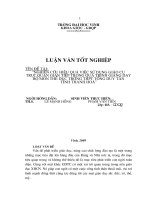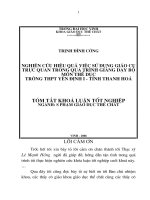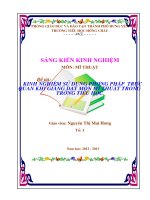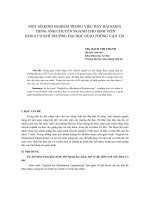ử dụng giáo cụ trực quan để giảng dạy hiệu quả từ vựng chuyên ngành cho sinh viên hệ Cao đẳng Điều dưỡng, Học viện Y-Dược học cổ truyền Việt Nam tt
Bạn đang xem bản rút gọn của tài liệu. Xem và tải ngay bản đầy đủ của tài liệu tại đây (144.59 KB, 5 trang )
1
VIET NAM NATIONAL UNIVERSITY, HA NOI
UNIVERSITY OF LANGUAGE & INTERNATIONAL STUDIES
FACULTY OF POST – GRADUATE STUDIES
*****************
PHẠM NGÂN HÀ
USING VISUAL AIDS FOR EFFECTIVE ESP VOCABULARY
TEACHING FOR STUDENTS AT NURSING COLLEGE,
VIETNAM ACADEMY OF TRADITIONAL MEDICINE
(Sử dụng giáo cụ trực quan để giảng dạy hiệu quả từ vựng chuyên ngành
cho sinh viên hệ Cao đẳng Điều dưỡng,
Học viện Y – Dược học cổ truyền Việt Nam)
M.A. Minor Programme Thesis
Field: English Teaching Methodology
Code: 60 14 10
Hanoi, 2010
2
VIET NAM NATIONAL UNIVERSITY, HA NOI
UNIVERSITY OF LANGUAGE & INTERNATIONAL STUDIES
FACULTY OF POST – GRADUATE STUDIES
*****************
PHẠM NGÂN HÀ
USING VISUAL AIDS FOR EFFECTIVE ESP VOCABULARY
TEACHING FOR STUDENTS AT NURSING COLLEGE,
VIETNAM ACADEMY OF TRADITIONAL MEDICINE
(Sử dụng giáo cụ trực quan để giảng dạy hiệu quả từ vựng chuyên ngành
cho sinh viên hệ Cao đẳng Điều dưỡng,
Học viện Y – Dược học cổ truyền Việt Nam)
M.A. Minor Programme Thesis
Field: English Teaching Methodology
Code: 60 14 10
Supervisor: Trần Hiền Lan, M.A
Hanoi, 2010
7
TABLE OF CONTENT
Declaration ……………………………………………………………………………
i
Acknowledgement ……………………………………………………………………
ii
Abstract……………………………………………………………………………………
iii
List of abbreviations ……………………………………………………………………
iv
Table of content ………………………………………………………………………
v
PART 1 - INTRODUCTION …………………………………………………………
1
1. Rationale of the research ……………………………………………………………
1
2. Aims of the research ………………………………………………………………….
2
3. Scope of the research ………………………………………………………………
2
4. Methods of the research ………………………………………………………………
2
PART 2 – DEVELOPMENT ……………………………………………………………
3
CHAPTER 1 - THEORETICAL BACKGROUND …………………………………
3
1.1. An overview of ESP ……………………………………………………………
3
1.1.1. Definition of ESP ………………………………………………………………
3
1.1.2. Classification of ESP ……………………………………………………………
4
1.1.3. The roles of ESP teachers …………………………………………………………
6
1.2. Vocabulary and vocabulary in ESP teaching ……………………………………
7
1.2.1. Definition of vocabulary ………………………………………………………
7
1.2.2. Classification of vocabulary and ESP vocabulary ………………………………
7
1.2.3. The importance of vocabulary in language learning and teaching …………….
9
1.2.4. Principles of vocabulary teaching ……………………………………………
9
1.2.5. Criteria for selection of vocabulary ……………………………………………
9
1.2.6. What needs to be taught ………………………………………………………….
10
1.2.6.1. Forms of a word …………………………………………………………………
10
1.2.6.2. Meaning ………………………………………………………………………….
10
1.2.6.3. Use of a word …………………………………………………………………….
11
1.3. Visual aids in teaching and learning vocabulary ………………………………….
11
1.3.1. Visual aids as one kind of teaching aids ………………………………………….
11
8
1.3.2. What can be used as visual aids in teaching and learning vocabulary ………
11
1.3.3. Advantages and disadvantages of visual aids in teaching vocabulary ………
13
1.3.3.1. Advantages of visual aids in teaching vocabulary …………………………
13
1.3.3.2. Disadvantages of visual aids in teaching vocabulary …………………………
14
1.4. Techniques in vocabulary presenting ……………………………………………
14
1.4.1. Visual techniques ………………………………………………………………
15
1.4.2. Verbal techniques …………………………………………………………………
15
1.4.3. Translation ………………………………………………………………………
15
1.4.4. Techniques in practicing new words …………………………………………
16
1.4.5. Principles for choosing visual aids ……………………………………………
16
1.5. Summary …………………………………………………………………………….
18
CHAPTER 2 - THE RESEARCH ……………………………………………………
19
2.1. Situation analysis ……………………………………………………………………
19
2.1.1. Fast facts about teaching and learning vocabulary at Vietnam Academy of
Traditional Medicine (VATM) …………………………………………………
19
2.1.1. The course objective and the textbook “English for Medical Purposes
(EMP): A Designed-On-Demand Communication Course” …………………
19
2.1.2. Students’ background and vocabulary learning ………………………………
20
2.1.3. The present situation of ESP teaching and learning at VATM ………………
20
2.2. Research methodology ………………………………………………………………
22
2.2.1. Research questions ………………………………………………………………
23
2.2.2. Research methods …………………………………………………………………
23
2.3. Data analysis …………………………………………………………………………
24
2.3.1. Data analysis of the survey questionnaires ………………………………………
24
2.3.2. Data analysis of the interview …………………………………………………….
32
2.4. Summary……………………………………………………………………………
33
CHAPTER 3 - DISCUSSION OF MAJOR FINDINGS AND
RECOMMENDATIONS ………………………………………………………………
35
3.1. Discussion of major findings ………………………………………………………
35
9
3.2. Recommendations …………………………………………………………………
35
PART 3 - CONCLUSION………………………………………………………………
35
1. Conclusions …………………………………………………………………………….
36
2. Limitations and suggestion for further studies ……………………………………
37
REFERENCES …………………………………………………………………………
38
APPENDICES ……………………………………………………………………………
I
Appendix 1 : Questionnaire for the teachers …………………………………………
II
Appendix 2 : Questionnaire for the students …………………………………………
III
Appendix 3: Nội dung phỏng vấn - Interview transcript …………………………….
IV









